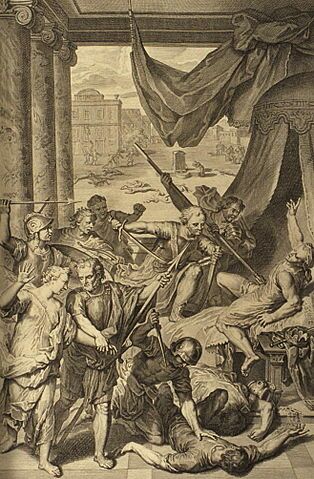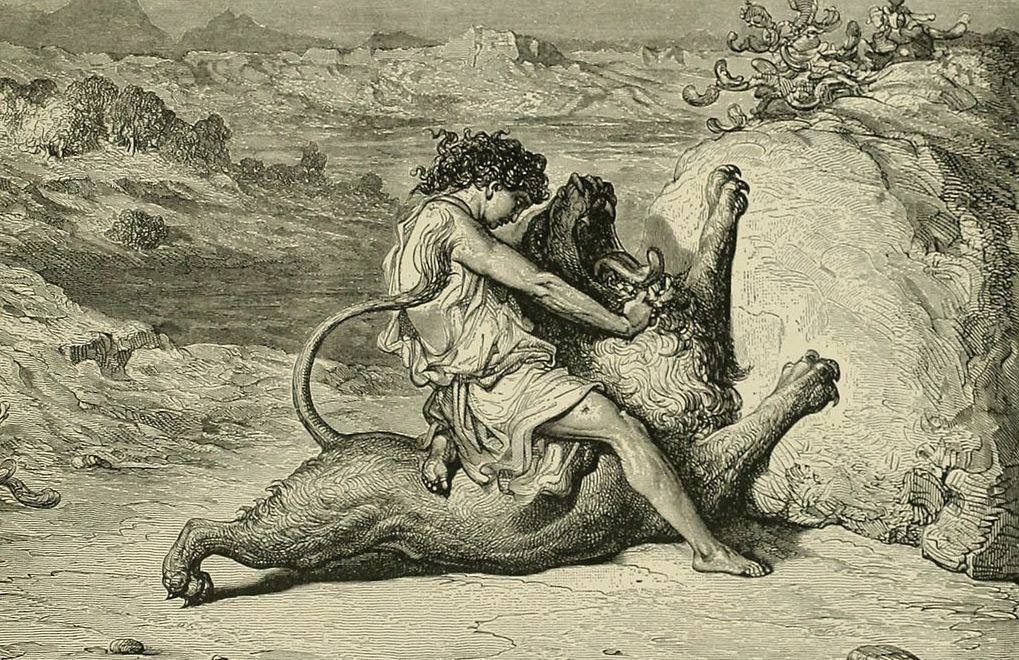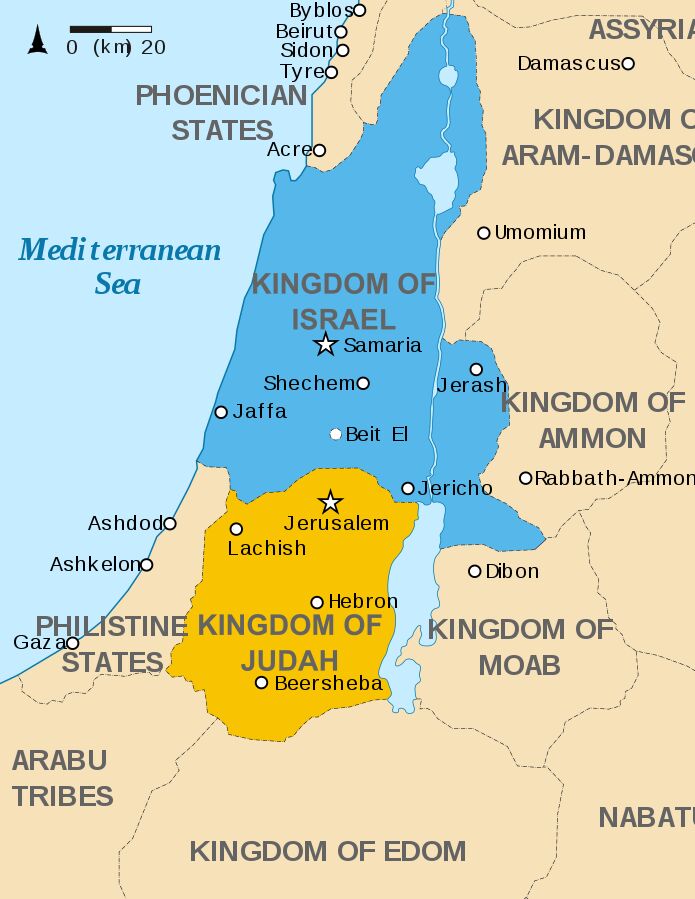The Spartans: ‘Children of Abraham, Brothers of the Jews’
They are famous as a savage, militaristic society built entirely around their armed forces. Spartan men existed to make war. Spartan women existed to make warriors. And Spartan slaves existed to do essentially everything else. They are probably best known for their lopsided stand against the giant Persian army at the Battle of Thermopylae, reimagined in the famously inaccurate film 300.
And, according to an early third-century b.c.e. letter from Spartan King Areus i to the Jewish ruler Onias i, they were also “descendants of Abraham” and “brothers” of the Jews.
The remarkable letter from the Lacedemonian king (the official name of the Spartan territory) is presented by first-century c.e. historian Josephus in his book Antiquities of the Jews, as well as in 1 Maccabees 12. It follows (quoted here from Josephus’s Antiquities, 12.4.10):
Areus, King of the Lacedemonians, to Onias, sendeth greeting:
We have met with a certain writing, whereby we have discovered that both the Jews and the Lacedemonians are of one stock, and are derived from the kindred of Abraham. It is but just therefore that you, who are our brethren, should send to us about any of your concerns as you please. We will also do the same thing, and esteem your concerns as our own, and will look upon our concerns as in common with yours. Demoteles, who brings you this letter, will bring your answer back to us. This letter is four-square; and the seal is an eagle, with a dragon in his claws.
There is no record of Onias’s reply (as an aside—Onias was the son of Jaddua, the last chronological biblical high priest mentioned in Nehemiah 12:22). However, over a century later, 1 Maccabees 12 records a follow-up message sent to Sparta by the embattled high priest Jonathan, attempting to shore up alliances.
But how could Jews and Spartans be related? What did the Spartans’ “certain writing” say?
Theories of Origin
The cited Spartan genealogy is lost to history. A number of interesting theories exist on how—or if—the Spartans are descended from Abraham. The earliest history of the Spartans/Lacedemonians remains a mystery; the earliest mention of the name is on a series of Late Bronze Age tablets (circa 13th to 12th centuries b.c.e.).
William Whiston, known for his translation of Josephus into English, adds a footnote speculating on the Spartans’ connection to Abraham:
Whence it comes that these Lacedemonians declare themselves here to be of kin to the Jews, as derived from the same ancestor, Abraham, I cannot tell, unless, as [the 17th-century intellectual] Grotius supposes, they were derived from the Dores, that came of the Pelasgi. These are, by Herodotus, called barbarians; and perhaps were derived from the Syrians and Arabians, the posterity of Abraham by Keturah [another wife, described after Sarah’s death].
Another of Whiston’s theories is that they derived from Abraham’s servant “son,” Eliezer of Damascus (Genesis 15).
The Spartans being descendants of Keturah seems to be a fairly standard suggestion. But another interesting theory is that the Spartans were quite literally “brothers of the Jews”—that they were descendants of a “missing” Israelite tribe.
What Happened to the Simeonites?
The book of Numbers contains census figures for the Israelite exodus out of Egypt. One census is taken at the start of the journey, counting the number of military-able men for each tribe; another census is taken at the end. Overall, the raw population numbers do not change dramatically—plus or minus around 10,000 individuals for each tribe—with one notable exception: The tribe of Simeon practically falls off the map.
Simeon started out the journey from Egypt with the third largest tribe: nearly 60,000 military-able men, from six different clans. But by the arrival of the Israelites in Canaan, only 22,000 remained, from only five different clans. What happened to nearly two thirds of the tribe—including one entire clan? And why are the Simeonites hardly mentioned at all in Israelite history—in fact, completely omitted from the Deuteronomy 33 “tribal blessings”?
One theory is that a large portion of the tribe broke off partway through the wilderness journey, leaving the Israelite camp (perhaps the catalyst being the execution of a Simeonite prince for relations with a Midianite prostitute; Numbers 25)—and that these became, at least in part, the early Spartans, “brothers of the Jews.” A number of reasons are highlighted for this theory.

The Simeonites were known for militarism and savagery, based on the traits of their patriarch Simeon. Jacob prophesied of Simeon’s future descendants: “instruments [or weapons] of cruelty are in their habitations” (Genesis 49:5; King James Version). Jacob continued to highlight the “anger,” “wrath,” “fierceness” and “cruelty” of the tribe. Jewish tradition holds that it was the patriarch Simeon who proposed killing his brother Joseph, and who pushed him into the well—and indeed, Joseph later imprisoned Simeon in Egypt (Genesis 42). Simeon is chiefly known for his revenge killing of the men of an entire city, together with his brother Levi, after the leader raped their sister, Dinah (Genesis 34). The Simeonite tribe, then, was associated with a foundation of mass murder, deception, pillaging and abduction. As such, the patriarch Jacob prophesied that the tribe would become scattered.
The Spartans were not native to Greece. The historian Herodotus wrote that the Spartans arrived in Greece from Egypt. The Spartans are also noted for celebrating new moons—an Israelite practice—and the seventh day of the month (author Steven Collins, who writes about this Simeon-as-Sparta theory, explains that this could be a corruption of worship on the seventh day of the week). And the Spartans are known to have worshiped a “great lawgiver” from their “dim past”—whom Collins suggests could be Moses.
Mycenaean Israelites
An Israelite connection with the Mycenaean world is nothing new: Strong links are already known with another Israelite tribe—Dan. It is in relation to this tribe that another link with the Spartans is suggested.
The ancient Greek poet Homer wrote about a seafaring tribe called Danaoi, or Danaan, who fought alongside the Greeks at the Battle of Troy. The biblical tribe of Dan was also known as a seafaring tribe—and was actually condemned around this time in history (circa 13th century b.c.e.) for being away “in their ships.” Furthermore, the Bible directly relates Dan with Greece (Ezekiel 27:19; “Javan” is the Hebrew name for Greece).
Excavations at Dan’s “capital” in Israel, Tel Dan, have revealed a number of Greek artifacts. And the late Israeli archaeologist Yigael Yadin suggested a link between the Danites and the seafaring Denyen people, linked to the mysterious north-Levant land of “Danuna” (matching the northern territory of Dan/Tel Dan?)—again, possibly all one and the same as Homer’s Danaoi/Danaan.
According to Greek legend, the patriarch of the Danaoi tribe was Danaus, son of Belus, who likewise came to Greece from Egypt, fleeing from his brother-ruler Aegyptus. Could this be a parallel with the tribal patriarch Dan, son of Jacob and Belhah, and his brother-ruler of Egypt, Joseph?
The most famous Danaoi descendant was the strongman Hercules. This individual is actually a close parallel to the famous strongman from the tribe of Dan: Samson. Both killed a lion with their bare hands. Both were responsible for the death of their first wives in a fire. Both singlehandedly wiped out armies. Both faced off against enemies fielding giants. Both are known for their signature use of club-weapons. Both are associated with “multi-headed” canines, as well as snakes. Both drank water that miraculously came from a rock. Both tore down the gates of a city. Both had a weakness for women. And both unwittingly met their demise at the hands of a lover (identified as a “man-destroyer”) who betrayed them—Samson by Delilah, Hercules by Deanirah—to name some examples.

The Hebrew word for “merchants”—one of the tribe of Dan’s noted professions—is Haroclem, similar to the Greek name of Hercules, Heracles. Could Hercules, then, have been one and the same as Samson? Could what became a fantastical Greek legend have been seeded by Danite merchants? And could the same explanation be given for numerous other similar biblical parallels appearing in Greek legends?
First millennium Sparta was peculiar in that it was ruled simultaneously by two hereditary kings—both proudly traced their genealogy from Heracles. Perhaps the “certain writing” genealogy that Spartan King Areus i highlighted was his genealogical link to the Israelites through a descendant from this individual. (After all, Samson had a penchant for women of Aegean origin—the Philistines.)
As for physical appearance: Shortly after recording the letter of Areus i, Josephus makes an interesting note—just how identical the Jewish and Greek people looked, the fact that they could readily pass themselves off for Greeks (Antiquities, 12.5.1).
Israelites: Not Only Jews
Whether or not the Spartans were descendants of Dan, Simeon or Keturah (or all of the above) is an interesting study, but a side point to a bigger picture: The Jewish people, of course, make up only a fraction of the descendants of Abraham.
Abraham was promised by God that his descendants would be “multipl[ied] exceedingly,” that he would be a “father of a multitude of nations” (Genesis 17:2, 4). Besides the Israelites, Abraham is the father of the Ishmaelites (the Arab nations of today). He is likewise the father of the Midianites (Genesis 25:2) and the Edomites (Genesis 36:1), just to name just a few. Abraham indeed has become a “father of nations,” numbering many tens of millions in the Middle East today, and of which the Jews around the world make up a fraction: roughly 15 million.
But the promise of gigantic future populations was not for Abraham’s descendants in general. This blessing was specifically directed to Abraham’s son Isaac (Genesis 26:4; kjv)—the promise of descendants “as the stars of heaven,” that would be given “all these countries,” and from whom would “all the nations of the earth be blessed.” From Isaac, the blessing was passed on specifically to his son Jacob (the Israelites), not Esau (the Edomites): “[T]hy seed shall be as the dust of the earth,” Jacob was promised (Genesis 28:14).
So among all of the Abrahamic nations—all of Abraham’s descendants—have the Jewish people been the primary fulfillment this prophecy of multitudes, passed down specifically to Jacob? The numbers state otherwise.
Contrary to general belief, the Jews represent only a fraction of the Israelites, let alone all the descendants of Abraham. All Jews are Israelites, but most Israelites are not Jews! In fact, the first time the word Jews is mentioned in the Bible is in a passage describing a battle between the Jews and the Israelites (2 Kings 16).
The word Jew (Hebrew: Yehudi) is simply the name for a person of the tribe of Judah (Yehuda). Thus, the Jewish people of the world represent one tribe, primarily.

The national separation of Jews and Israelites occurred during the oppressive reign of the 10th-century Judahite king Rehoboam. The northern 10 tribes of Israel split off and formed their own kingdom, under King Jeroboam—the kingdom of Israel—while the tribe of Judah (together with the small tribe of Benjamin and a part of the tribe of Levi), became the southern kingdom of Judah (1 Kings 11).
Three hundred years later (721–718 b.c.e.), the larger kingdom of Israel was conquered by Assyria and deported wholesale from their land (2 Kings 17). The last geographical marker given is northern Iran (verse 6), before they are completely lost to world view. Today, they are known as the “lost 10 tribes”—and from this point on, the Bible focuses only on the Jews (again, primarily Judah, with a small population of Benjamin and Levi). These are the descendants who feature in the “Jewish return” of Ezra and Nehemiah—labeled specifically as being from these three tribes—and who inhabited Judea through the Hellenistic, Hasmonean and Roman periods. These are the descendants to whom King Areus i of Sparta wrote.
So where did the bulk of the Israelites go? Who are their descendants?
Consider that of the three major Abrahamic religions—Judaism, Islam and Christianity—only members of the first two groups, Jews and Muslims, are generally recognized as descendants of Abraham. Could Abraham’s descendants also make up a bulk of the Christian world, centered in the European continent? And could the prophetic promise specifically passed down to the descendants of Jacob—of extraordinary populations, control of numerous “countries,” “nations,” “isles” and a direct influence on all the nations of the Earth—have been fulfilled primarily by the migration of these “lost 10 tribes” from Asia Minor into Europe (and later into the Americas)?
After all, what is not so well known about the New Testament is that only one apostle, Paul, was assigned to “the Gentiles” (Romans 11:13). The other twelve were told to “[g]o not into the way of the Gentiles” (Matthew 10:6). Instead, they disappeared overseas, sent far and wide from Judea to the “lost sheep” of Israel—the “twelve tribes which are scattered abroad” (James 1:1).
The where is a topic for another article. Needless to say, there are far more “brothers of the Jews” out there than just the small Spartan civilization of old.